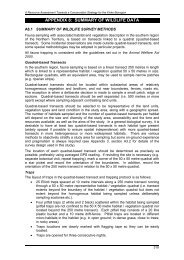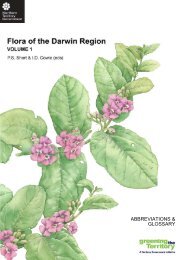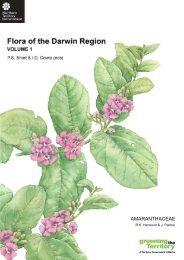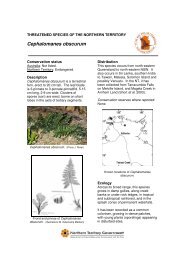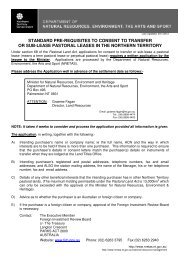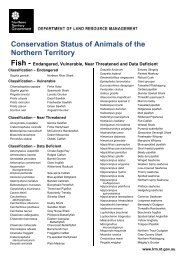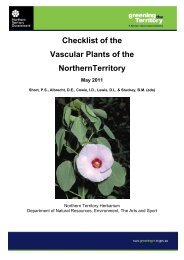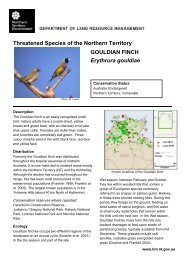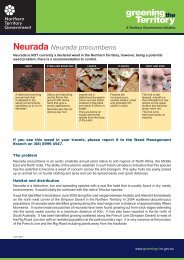CUCURBITACEAE - Department of Land Resource Management
CUCURBITACEAE - Department of Land Resource Management
CUCURBITACEAE - Department of Land Resource Management
You also want an ePaper? Increase the reach of your titles
YUMPU automatically turns print PDFs into web optimized ePapers that Google loves.
12<br />
and common in an array <strong>of</strong> habitats including<br />
monsoon forest and vine thickets, on sandy soil<br />
along water courses, on the margins <strong>of</strong> Melaleuca<br />
swamps, and on outcrops <strong>of</strong> limestone, sandstone<br />
or granite. Locations include Nitmiluk N.P.,<br />
Humpty Doo, Cobourg Peninsula, Cape Hotham,<br />
Wagait, Litchfield N.P., Bonnie Ranges (near Pine<br />
Creek), Mt Burrell (Tipperary Station), the Douglas<br />
River area, headwaters <strong>of</strong> Hayward Creek, and<br />
tributaries <strong>of</strong> the Adelaide River.<br />
T. holtzei F. Muell.<br />
Annual trailing or climbing vine, apparently<br />
dioecious (female flowers have not been<br />
observed); stems angled with scattered simple<br />
hairs. Tendrils 2-branched. Leaves simple; petioles 10–<br />
45 mm long, with scattered hairs; lamina entire<br />
or shallowly to deeply palmately 3-lobed, 60–<br />
125 (155) mm long, 50–120 (145) mm wide;<br />
margins sinuate-dentate; base cordate; apex<br />
obtuse to acute; lower lamina surface or both<br />
surfaces velvety, rarely glabrous. Male flowers in 2–<br />
13-flowered axillary racemes to 18 cm long,<br />
occasionally solitary, sparsely to densely glandular<br />
hairy; bracts narrowly ovate to obovate, apex<br />
acute, longer than wide; pedicels 4–30 mm; calyx<br />
lobes narrowly triangular, 2.5–4 mm long; corolla<br />
lobes triangular to ovate, 6–10 mm long, fimbriae<br />
to 25 mm long; anthers connate forming a<br />
globular head 2.5–3 mm long. Female flowers not<br />
observed. Fruit ovoid, 40–60 mm long, 25–40 mm<br />
diam., beaked, ripening to orange or red; pedicels<br />
15–20 mm long. Seeds numerous, broadly ovate,<br />
3-locular, c. 7 mm long, pale brown. Flowering &<br />
fruiting: Oct.–Mar.<br />
Fig. 3 (Cowie 3620; Russell-Smith 4768 & 5135).<br />
Australia (N.T., Qld). Grows on sandy soils in<br />
coastal vine forest, monsoon forest and semideciduous<br />
vine forest on old, stabilised dunes and<br />
in swales behind dunes. Localities include, Groote<br />
Eylandt and Van Diemen Gulf. In the D.R. nonflowering<br />
specimens have been collected from<br />
Wagait Reserve, Melville Island and Gunn Point.<br />
T. sp. Fine Leaf (L.A. Craven 7930)<br />
N.T. Herbarium<br />
Trailing or climbing vine; stems angled, glabrous<br />
or occasionally with scattered multicellular hairs<br />
to 2 mm long. Tendrils 2- or more rarely 3branched.<br />
Leaves simple; petioles 8–30 mm long,<br />
with a cover <strong>of</strong> sparse to dense glandular hairs,<br />
occasionally densely hairy, with hairs to 2 mm<br />
long; lamina widely depressed-ovate to widely<br />
<strong>CUCURBITACEAE</strong><br />
ovate, 5–7-palmately lobed, finely and very deeply<br />
divided, 45–85 mm long, 40–100 mm wide;<br />
margins shallowly lobulate; base cordate; apex<br />
obtuse to acute with a small spine; lower leaf<br />
lamina surface with sparse hairs, upper surface<br />
with glandular hairs along veins and occasionally<br />
on the lamina. Male flowers in 3–15-flowered<br />
axillary racemes to 16 cm long; bracts<br />
suborbicular, 1–2 mm long, frequently wider than<br />
broad; pedicels 3–15 mm long; calyx lobes<br />
triangular c. 2 mm; corolla lobes triangular to<br />
ovate, 6–12 mm long, fimbriae to 25 mm long;<br />
anthers connate forming a globular head c. 3 mm<br />
long. Female flowers not observed. Fruit subglobular,<br />
beaked, glabrous, 15–30 mm long, 15–<br />
25 mm wide, green with darker green stripes,<br />
ripening to a uniform yellow, orange or red;<br />
pedicels 5–12 mm long. Seeds numerous, ovate,<br />
6.5–10 mm long, 4–6 mm wide, 2.5–4 mm thick,<br />
grey, pale pink, cream coloured or white, with<br />
wavy margins and a notch at the apex. Flowering:<br />
Jan.–June. Fruiting: Feb.–July.<br />
Fig. 3 (Craven 7930; Lazarides 9015; Makinson 1158).<br />
Australia (N.T.); from sandstone escarpments in<br />
Kakadu N.P. and eastern Arnhem <strong>Land</strong>.<br />
The specimen illustrated in the Flora <strong>of</strong> Australia as<br />
T. cucumerina var. cucumerina (Telford 1982, fig. 41<br />
A–D) is <strong>of</strong> this entity.<br />
T. sp. Kakadu (C.R. Dunlop 6639)<br />
N.T. Herbarium<br />
Trailing or climbing vine, stems angled and<br />
glabrous. Tendrils 3-branched. Leaves simple;<br />
petioles 25–65 mm long, glabrous; lamina widely<br />
to very widely ovate, palmately 3- (5-) lobed, 105–<br />
170 mm long, 95–135 mm wide; margins entire<br />
or slightly sinuate-dentate; base cordate; apex<br />
acute occasionally with a small spine to 4 mm<br />
long; undersurface <strong>of</strong> lamina glabrous but with<br />
occasional, scattered large glands 0.5–0.75 mm<br />
diam., veins raised; upper surface beset with<br />
numerous small glands. Flowers not observed. Fruit<br />
ripening to red, seeds packed in greenish-black<br />
mucilage. Fruiting: Feb.<br />
Fig. 3 (Russell-Smith 2798 & 8056).<br />
Seemingly endemic to the Top End <strong>of</strong> the N.T.<br />
with specimens found from Kakadu N.P. east to<br />
Groote Eylandt. Occurs in coastal vine forest,<br />
riparian vegetation and on sandstone escarpments.<br />
Flowering material has yet to be collected and this<br />
entity may prove to be T. tricuspidata Lour.<br />
FDRV1 March 2011



